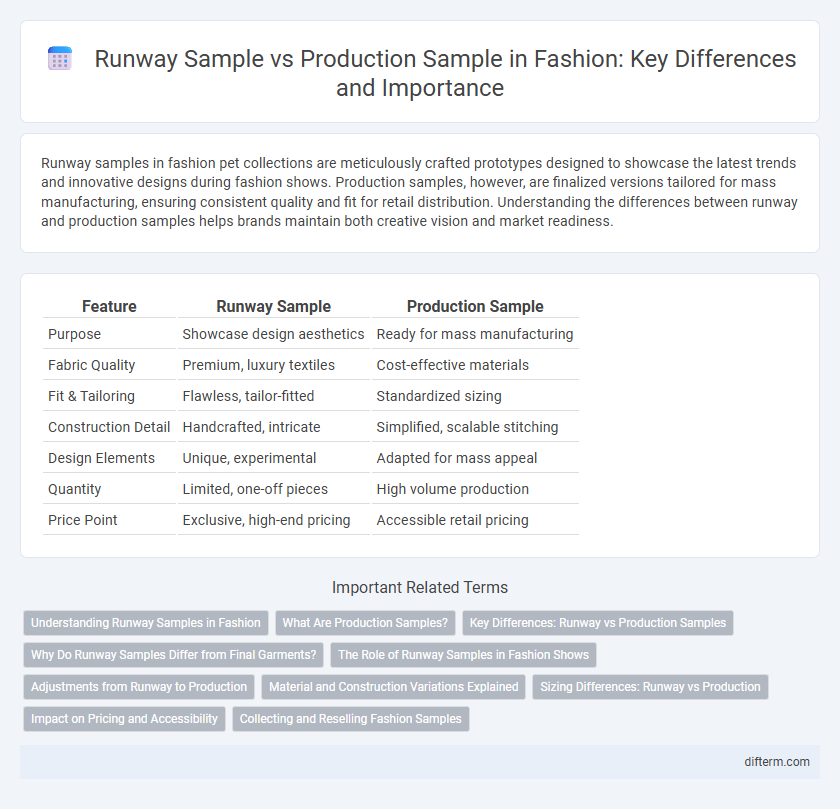Runway samples in fashion pet collections are meticulously crafted prototypes designed to showcase the latest trends and innovative designs during fashion shows. Production samples, however, are finalized versions tailored for mass manufacturing, ensuring consistent quality and fit for retail distribution. Understanding the differences between runway and production samples helps brands maintain both creative vision and market readiness.
Table of Comparison
| Feature | Runway Sample | Production Sample |
|---|---|---|
| Purpose | Showcase design aesthetics | Ready for mass manufacturing |
| Fabric Quality | Premium, luxury textiles | Cost-effective materials |
| Fit & Tailoring | Flawless, tailor-fitted | Standardized sizing |
| Construction Detail | Handcrafted, intricate | Simplified, scalable stitching |
| Design Elements | Unique, experimental | Adapted for mass appeal |
| Quantity | Limited, one-off pieces | High volume production |
| Price Point | Exclusive, high-end pricing | Accessible retail pricing |
Understanding Runway Samples in Fashion
Runway samples are unique, carefully crafted garments designed to showcase the designer's vision during fashion shows, often featuring experimental techniques and materials not always present in production samples. These pieces serve as a visual story, setting trends and influencing the look of forthcoming collections while prioritizing aesthetics over mass production practicality. Understanding runway samples highlights their role as high-concept prototypes that guide the refinement process for production samples used in retail.
What Are Production Samples?
Production samples are finalized garment prototypes created after the approval of runway or pre-production samples, representing the exact specifications, fabric, and construction methods intended for mass manufacturing. These samples ensure quality control and consistency before full-scale production begins, serving as the benchmark for factories to replicate the design accurately. Production samples must meet strict standards in fit, stitching, fabric quality, and color fidelity to guarantee that the final retail products match the designer's vision.
Key Differences: Runway vs Production Samples
Runway samples are exclusive, high-quality garments created to showcase a designer's vision during fashion shows, often featuring experimental materials and intricate detailing not intended for mass production. Production samples are finalized versions made to exact specifications for mass manufacturing, ensuring consistency, fit, and durability across all retail units. Key differences include the level of refinement, practicality for wear, and adherence to manufacturing constraints, with runway samples prioritizing aesthetic impact and production samples focusing on scalability and cost-efficiency.
Why Do Runway Samples Differ from Final Garments?
Runway samples differ from final garments because they are designed primarily to showcase the designer's vision with exaggerated details and flawless craftsmanship, often using higher-quality materials and more intricate construction techniques. Production samples must balance aesthetics with practicality, focusing on cost-efficiency, durability, and manufacturability to meet mass-market demands and size variations. This difference ensures that final garments maintain the essence of the runway look while being accessible and wearable for consumers.
The Role of Runway Samples in Fashion Shows
Runway samples are meticulously crafted prototypes designed to showcase the designer's vision during fashion shows, highlighting innovative cuts, fabrics, and intricate details that set trends for upcoming seasons. These samples often differ from production samples, which are mass-produced and refined for retail, focusing on wearability, cost efficiency, and durability. The impact of runway samples lies in their ability to attract buyers, media attention, and influence the final production process by demonstrating the full creative potential of a collection.
Adjustments from Runway to Production
Runway samples often feature experimental designs and custom fits tailored for dramatic visual impact, requiring extensive adjustments for mass production standards. Production samples focus on practicality, durability, and consistency, involving modifications in fabric choice, stitching techniques, and sizing to meet manufacturing and consumer demands. These adjustments ensure the final product balances runway aesthetics with wearability and quality control for retail distribution.
Material and Construction Variations Explained
Runway samples often feature experimental materials and intricate construction techniques designed to highlight creative vision, while production samples prioritize durability and cost-efficiency with standardized fabrics and streamlined assembly methods. Material variations between runway and production samples include the use of premium textiles and hand-finished details in runway pieces compared to mass-produced alternatives in production runs. Construction differences emphasize artisanal craftsmanship on runway samples, contrasting with machine-driven processes designed for scalability in production samples.
Sizing Differences: Runway vs Production
Runway samples often feature exaggerated or slimmed-down sizing to enhance visual impact on the catwalk, whereas production samples align with standardized sizing to ensure consistent fit for retail consumers. These sizing differences mean runway pieces may not accurately represent the final product's proportions or comfort. Production samples undergo rigorous fit testing to meet diverse body measurements and retail market demands, contrasting with the more artistic and form-focused runway versions.
Impact on Pricing and Accessibility
Runway samples often feature unique, high-quality materials and intricate detailing that elevate production costs, resulting in higher prices and limited accessibility for consumers. Production samples are designed for mass manufacturing, prioritizing cost-efficiency and scalability, which lowers prices and increases availability. Understanding the distinction between these samples helps brands balance exclusivity with market demand, optimizing both pricing strategies and consumer reach.
Collecting and Reselling Fashion Samples
Runway samples, designed for initial presentation and showcasing designer creativity, often feature exclusive details not found in production samples, making them highly sought after by collectors. Production samples are closer to final retail versions but may differ slightly in materials or construction, offering a unique insight into the garment's evolution. The resale market values runway samples for their rarity and authenticity, while production samples appeal to those seeking near-retail quality with a story behind the piece.
Runway sample vs Production sample Infographic

 difterm.com
difterm.com